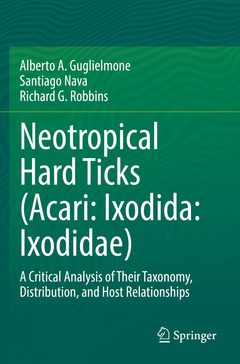Description
Neotropical Hard Ticks (Acari: Ixodida: Ixodidae), 1st ed. 2021
A Critical Analysis of Their Taxonomy, Distribution, and Host Relationships
Authors: Guglielmone Alberto A., Nava Santiago, Robbins Richard G.
Language: English
Subjects for Neotropical Hard Ticks (Acari: Ixodida: Ixodidae):
158.24 €
In Print (Delivery period: 15 days).
Add to cartPublication date: 07-2022
486 p. · 15.5x23.5 cm · Paperback
158.24 €
In Print (Delivery period: 15 days).
Add to cartPublication date: 07-2021
486 p. · 15.5x23.5 cm · Hardback
Description
/li>Contents
/li>Biography
/li>Comment
/li>
Of the 758 species of hard ticks (family Ixodidae) currently known to science, 137 (18%) are found in the Neotropical Zoogeographic Region, an area that extends from the eastern and western flanks of the Mexican Plateau southward to southern Argentina and Chile and that also includes the Greater and Lesser Antilles and the Galápagos Islands. This vast and biotically rich region has long attracted natural scientists, with the result that the literature on Neotropical ticks, which are second only to mosquitoes as vectors of human disease and are of paramount veterinary importance, is enormous, diffuse, and often inaccessible to non-specialists. In this book, three leading authorities on the Ixodidae have combined their talents to produce a summary of essential information for every Neotropical tick species. Under each species name, readers will find an account of the original taxonomic description and subsequent redescriptions, followed by an overview of its geographic distribution and host relationships, including a discussion of human parasitism. Additional sections provide detailed analyses of tick distribution by country and zoogeographic subregion (the Caribbean, southern Mexico and Central America, South America, and the Galápagos Islands), together with a review of the phenomenon of invasive tick species and examination of the many valid and invalid names that have appeared in the Neotropical tick literature. The text concludes with an unprecedented tabulation of all known hosts of Neotropical Ixodidae, including the tick life history stages collected from each host. This book is an invaluable reference for biologists and biomedical personnel seeking to familiarize themselves with the Neotropical tick fauna.
Alberto A. GUGLIELMONE is a senior Argentinean scientist with a long career devoted to ticks and tick-borne diseases of cattle but currently specializing in the biogeography of Ixodidae worldwide. His scientific contributions encompass hundreds of papers and several books in collaboration with scientists in about 30 countries. Dr. Guglielmone is a member of the Academia Nacional de Agronomía y Veterinaria of Argentina.
Santiago NAVA is a Senior Scientist in Parasitology at the Instituto Nacional de Tecnología Agropecuaria, and Scientist at the Consejo Nacional de Investigaciones Científica y Técnicas, Argentina. His scientific contributions include more than two hundred papers and a book, with emphasis on the systematics, ecology and control of ticks, as well as the epidemiology of tick-borne pathogens. Dr. Nava actively collaborates with scientists from more than 20 countries in the Americas, Europe and Africa.
Richard G. ROBBINS is an Emeritus Research Associate at the Smithsonian Institution. His 41-year career with four United States government agencies has yielded approximately 150 scientific publications, including six books and several book chapters and monographs, plus scores of agency-specific reports. Dr. Robbins is a life member of the Society of Federal Health Professionals and has been awarded the U.S. Army’s Meritorious Civilian Service Medal.
A single-source reference to essential taxonomic and biological information for every species of hard tick in the Neotropical Region
A detailed account of Neotropical ixodid tick zoogeography and host associations
A unique discussion of comparative host usage and the ranges of tick genera (Amblyomma, Ixodes, Dermacentor, Haemaphysalis and Rhipicephalus) within Neotropical subregions




